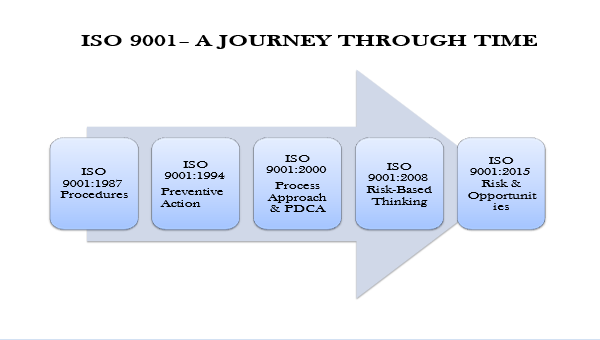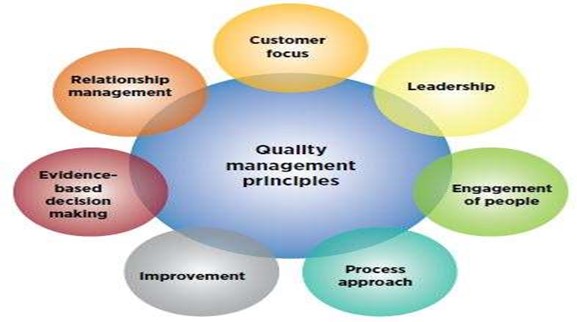What is ISO 9001:2015?
ISO 9001:2015 is an international standard for Quality Management Systems (QMS). It provides a framework for improving quality and a vocabulary of understanding for any organization looking to provide products and services that consistently meet customers’ requirements and other relevant interested parties. The QMS is the aggregate of all the processes, resources, assets, and cultural values that support the goal of customer satisfaction and organizational efficiency. This standard was first published in 1987, the latest iteration (ISO 9001:2015) replaces ISO 9001:2008.
ISO 9001:2015 does not dictate how anyone should run their business, or what an organization’s objectives or policy should be, or how to achieve them. It is a flexible standard that allows each organization to define for itself its objectives, policy, and processes. ISO 9001:2015 defines the guiding principles that can be used to create efficiencies by aligning and streamlining processes throughout the organization, to cut costs, create new opportunities, meet regulatory requirements, and help organizations expand into new markets in which clients demand ISO 9001 certification.
The International Organization for Standardization (ISO) does not conduct certifications to ISO 9001:2015. Instead, organizations engage an independent certification body (registrars) to audit their QMS implementation against the ISO requirements. Organizations of any size can certify to this standard, despite its size.
Important Dates

ISO 9001:2015 was published in September 2015 and is already the most widely adopted standard in the history of standards. To help the more than 1 million companies that have certified to ISO 9001:2008 transition to the new standard, ISO had put in place a three-year transition period during which ISO 9001:2008 certification will remain valid. This transition expired in September 2018. It is important to note that after 2018, ISO 9001:2008 certified companies that had not certified to ISO 9001:2015 lost their ISO 9001 certification until they recertify to the new standard.
“ISO 9001:2015 was published in September 2015 and is already the most widely adopted standard in the history of standards.”
Many people have heard the term “ISO standard” and wondered what ISO is and how it became the guardian of standardization. ISO (from Greek isos meaning “equal”) is the “International Organization for Standardization,” a non-governmental organization based in Geneva, Switzerland. It is dedicated to developing voluntary standards that ensure product safety and quality while encouraging innovation in a global marketplace. ISO dates from 1947, after a meeting at the Institute of Civil Engineers in London at which delegates from 25 countries met to coordinate international standards for industrial manufacturing.
ISO’s fundamental mission is to provide common specifications, terms, standards, and units of measurement to organizations around the world. ISO does not provide certification or conformity assessment. Rather, it facilitates global trade and innovation to allow every organization in every sector from around the world to have a common language and common expectations, from technology and manufacturing to food safety, healthcare, and agriculture. ISO has published more than 22,000 standards since its first published standard in 1951.
ISOs overall mission is built on the following core initiatives for its members:
- Strengthening the links between standardization and public policy by providing thought leadership and promoting awareness of best practices.
- Identifying and building national standardization strategies by applying best practices.
- Ensuring the efficient operation of their organizations while managing financial sustainability and risk.
- Ensuring participation of, and collaboration with, key stakeholders in all standardization projects.
- Increasing adherence to Good Standardization Practices (GSP) among standards experts in every national organization and evaluating all processes to determine their alignment with the World Trade Organization (WTO) Technical Barriers to Trade (TBT) Agreement.
ISO consists of 161 standards bodies from around the world, with 776 technical committees and subcommittees. Developing a new standard from proposal to publication typically takes about three years and adheres to the following key principles:
- ISO develops standards in response to requests from industry stakeholders or to meet clear market demands.
- ISO develops standards based on the opinions of international experts. The technical committee then decides the scope and content for the standards.
- ISO develops standards according to a process that includes multiple stakeholders including consumer associations, academics, NGOs, and the public sector.
- ISO develops standards based on consensus and accounts for all feedback and requests for revisions.
ISO 9001:2015 and its complementary management standards are based on the following seven Quality principles:

These principles are the strategic basis for all decisions relating to Quality Management in the organization and are infused within all aspects of the ISO 9001:2015 language. Every organization will prioritize each principle in a different way at various stages of its development.
ISO 9001:2015 contains a subset of tactical elements that complement the strategic principles provided above. These five elements, which represent a significant advance on ISO 9001:2008, are:
The Plan-Do-Check-Act cycle
- Risk-based thinking
- Leadership participation
- Unified structure, and
- Clarified documentation requirements.
These elements are complementary and are highly integrated into the structure of ISO 9001:2015. As such, discussing them in isolation from one another is somewhat artificial and carries the danger of misrepresenting the organic quality of the standard. To accommodate this, we will look at a brief background of each element and summarize the structure in a table format to highlight their overall integration.
Plan-Do-Check-Act
Plan-Do-Check-Act (PDCA) is also called the Deming Cycle, it is a process approach that manages processes and systems to create a cycle of continuous improvement. It considers the QMS as an entire system and provides systematic management of the QMS from planning and implementation through to checks and improvement. PDCA helps organizations achieve better customer satisfaction and, consequently, higher levels of customer confidence in an organization’s abilities to meet customer requirements.

PDCA – It emphasizes and demonstrates that improvement programs must start with careful planning (Plan) to result in effective actions (Do) that are monitored (Check) for optimization (Act) and must move on again to careful planning in a continuous cycle.
Who can become certified ISO 9001:2015?
Organizations looking to become certified in ISO 9001:2015 are those who have never been certified to ISO 9001, and; those who are already certified to an obsolete standard (9001:2000 or 9001:2008) and need to update to ISO 9001:2015.
It is important to again note that ISO does not perform certifications. The International Accreditation Forum (IAF) evaluates assessment organizations all over the world and ensures they can suitably and uniformly accredit certification bodies to ISO standards.
The Seven Basic Quality Tools
Quality professionals have a dedicated set of tools for process analysis. These versatile tools can be useful at any stage of the QMS, from the initial gap analysis and internal audit to the cycle of continuous improvement. The table below shows a brief description of each tool:
| Tool | Description |
|---|---|
| Cause-and-Effect Diagram | This is also known as the “Ishikawa” or “fishbone chart” and can be used to identify the possible causes of a problem. |
| Check Sheet | This is a generic tool for capturing the frequencies and patterns of events such as defects or problems. |
| Control Chart | This is a graph that tracks how processes change over time. |
| Histogram | This is a tool for frequency distribution that shows how often different values occur. |
| Pareto Chart | This is a bar graph that shows the frequency of events in a process and determines which are the most significant. |
| Scatter Diagram | This is a graph that pairs variables and looks for relationships between them. |
| Stratification | This is a technique for separating and analysing data from different sources to uncover patterns. |
Conclusion
ISO 9001:2015 sets a global standard for Quality Management Systems and ensures their efficiency for products, services, and international supply chains. Whether an organization is starting down the path of a QMS or transitioning to the 2015 standard, ISO 9001:2015 embodies the best practices of Quality Management and Quality certification.
About Certfort
Certfort Limited is a Best Practise service provider established in 2019 to empower organizations to get it right at the first attempt, which enables them to stay ahead in the market and exceed their corporate objectives.
We are an independent certification body, poised to be one of the fastest-growing certification bodies in Africa. The Certfort team consists of highly experienced professionals offering the latest in systems and product certifications and quality improvements. We can be found here
References
- Quality management systems – Fundamentals and vocabulary, American Society for Quality, 2015, p. 1.
- Intelex article – What is ISO 9001:2015 and why is it important (February 1, 2019). https://www.qualitymag.com/articles/95235-what-is-iso-90012015-and-why-is-it-important
- “About ISO: Our Story,” International Organization for Standardization, accessed March 14, 2018, https://www.iso.org/ about-us.html
- “Quality Management Principles,” International Organization for Standardization, 2015.
- “The Process Approach in ISO 9001:2015,” International Organization for Standardization, p. 2.
- International Standard ISO 9001, Fifth Edition, 2015-09-15: Quality Management Systems – Requirements, International Organization for Standardization, p. ix.
- ISO 9001:2015, p. 1.
- “Keep Calm and Prepare for ISO 9001:2015,” Quality Progress, September 2015, p. 23.
- “Keep Calm and Prepare for ISO 9001:2015,” Quality Progress, September 2015, pp. 24-25.
- ISO 9001:2015, p. ix.
- ISO 9001:2015, p. 3.
- “Keep Calm and Prepare for ISO 9001:2015”, Quality Progress, September 2015, p. 21.
- ISO/IEC Directives, Part 1, Eighth edition, International Organization for Standardization, 2017, pp. 127-136.
- ISO 9001:2015, pp. 24-27.
- “ISO 9000: More Hindrance Than Help,” Quality Magazine, May 5, 2003, https://www.qualitymag.com/articles/84308- probing-the-limits-br-iso-9000-more-hindrance-than-help, accessed April 13, 2018.
- ISO/TR 10013, First Edition, 2001-07-15, Guidelines for quality management system documentation, International Organization for Standardization.
- ISO 9001:2015, 8-9.
- “Selection and use of the ISO 9000 family of standards,” International Organization for Standardization, 2016.
- ISO Survey – 2005, https://www.iso.org/files/live/sites/isoorg/files/archive/pdf/en/survey2005.pdf, accessed April 13, 2018.
- Nancy R. Tague, The Quality Toolbox, Second Edition, Milwaukee: ASQ Quality Press, 2005.
- “Correlation matrices between ISO 9001:2008 and ISO 9001:2015,” International Organization for Standardization, http://www.iso.org/tc176/sc02/public, accessed April 17, 2018.


One Response
Hello colleagues, fastidious paragraph and nice arguments commented here, I am truly enjoying by these.